Master System
The Sega Master System[lower-alpha 3] is a third-generation 8-bit home video game console manufactured by Sega. It was originally a remodeled export version of the Sega Mark III, the third iteration of the SG-1000 series of consoles, which was released in Japan in 1985 and featured enhanced graphical capabilities over its predecessors. The Master System launched in North America in 1986, followed by Europe in 1987, and Brazil in 1989. A Japanese version of the Master System was also launched in 1987, which features a few enhancements over the export models (and by proxy the original Mark III): a built-in FM audio chip, a rapid-fire switch, and a dedicated port for the 3D glasses. The Master System II, a cheaper model, was released in 1990 in North America and Europe.
 | |
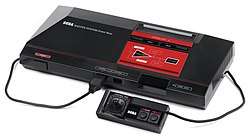 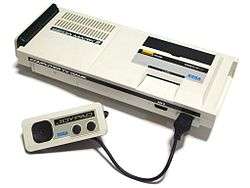 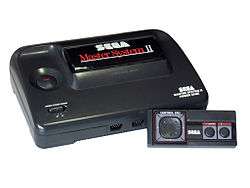 Top: North
American/European Master System Middle: Japanese Sega Mark III Bottom: PAL Master System II | |
| Manufacturer | Sega |
|---|---|
| Type | Home video game console |
| Generation | Third generation |
| Release date | |
| Lifespan |
|
| Introductory price | JP¥16,800 US$200 GB£99 |
| Units sold | Worldwide: 10–13 million (not including recent Brazil figures)[5][6] Japan: 1 million (as of 1986)[7] United States: 2 million (as of 1993)[8] Europe: 6.8 million (estimated as of December 1993)[9] |
| Media | ROM cartridge, Sega Card |
| CPU | Zilog Z80A @ 4 MHz |
| Memory | 8 kB RAM, 16 kB VRAM |
| Display | 256 × 192 resolution, 32 colors on-screen |
| Sound | Yamaha VDP PSG(SN76489), Yamaha YM2413[lower-alpha 1] |
| Backward compatibility | SG-1000[lower-alpha 2] |
| Predecessor | SG-1000 |
| Successor | Sega Genesis |
| Related articles | Game Gear |
The original Master System models use both cartridges and a credit card-sized format known as Sega Cards. Accessories for the consoles include a light gun and 3D glasses that work with a range of specially designed games. The later Master System II redesign removed the card slot, turning it into a strictly cartridge-only system and is incompatible with the 3D glasses.
The Master System was released in competition with the Nintendo Entertainment System (NES). Its library is smaller and with fewer well-reviewed games than the NES, due in part to Nintendo licensing policies requiring platform exclusivity. Though the Master System had newer, improved hardware, it failed to overturn Nintendo's significant market share advantage in Japan and North America. However, it attained significantly more success in Europe and Brazil.
Master System sales estimates are between 10 and 13 million units. Retrospective criticism has recognized its role in the development of the Sega Genesis, and a number of well received games, particularly in PAL (including PAL-M) regions, but is critical of its limited library in the NTSC regions, which were dominated by the Nintendo Entertainment System.
Development
In 1983, Sega released its first home console, the SG-1000, in Japan,[10] the same day its competitor Nintendo launched the Famicom.[11] In 1984, Sega's parent company Gulf and Western divested non-core businesses including Sega,[12] and Sega president Hayao Nakayama was installed as Sega CEO. Sega released another console, the SG-1000 II,[13] featuring several hardware alterations, including detachable controllers.[11]
Hoping to better compete with Nintendo,[14] Sega released another console, the Sega Mark III, in Japan in 1985.[13] The Mark III was a redesigned version of the SG-1000.[15] It was engineered by the same team,[16] including Masami Ishikawa, who had worked on the II and later led development of the Sega Genesis.[lower-alpha 4][17] According to console hardware R&D developer Hideki Sato, the console was designed because of the limitations of the TMS9918 graphics chip in the SG-1000 and II, which did not have the power for the kinds of games Sega wanted to make. The Mark III's chip was designed in-house, based around the unit in Sega's System 2 arcade system board.[14]
For the North American release, Sega rebranded the Mark III as the Master System, similar to Nintendo's reworking of the Famicom into the Nintendo Entertainment System. The name was chosen by Sega of America employees throwing darts against a whiteboard of suggested names. Plans to release a cheaper console, the Base System, also influenced the decision. Sega chairman Isao Okawa approved the name after being told it was a reference to the competitive nature of both the video game industry and martial arts, in which only one competitor can be the "Master".[18] The console's futuristic final design was intended to appeal to Western tastes.[16] The North American packaging was white to differentiate it from the black NES packaging, and the grid design was inspired by Apple products.[19]
Launch
Japan
The Sega Mark III was released in Japan in October 1985 at a price of ¥15,000.[1] Though its hardware was more powerful than the Famicom, the Mark III was not successful on launch. Problems arose from Nintendo's licensing practices with third-party developers, whereby Nintendo required that games for the Famicom not be published on other consoles. Sega developed its own games and obtained the rights to port games from other developers, but they did not sell well.[13] Sega developer Mark Cerny said "pressure was very, very high", with a typical Master System game allotted only three months of development time.[20]
The Mark III was rereleased as the Master System in Japan in October 1987 for ¥16,800,[4] but still sold poorly.[13] Neither model posed a serious challenge to Nintendo in Japan,[7] and, according to Sato, Sega was only able to attain 10% of the Japanese console market.[14]
North America
In North America, the Master System was launched in 1986 at a price of $200 (equivalent to $466 in 2019), including a multicart of the games Hang-On and Safari Hunt.[21] Nintendo was exporting the Famicom to the US as the NES, and both companies planned to spend $15 million in late 1986 to market their consoles; Sega hoped to sell 400,000 to 750,000 consoles in 1986.[22] By the end of 1986, 125,000 Master System consoles had been sold, more than the Atari 7800's 100,000 but less than Nintendo's 1.1 million.[3]
As in Japan, the Master System in North America had a limited game library. Limited by Nintendo's licensing practices, Sega only had two third-party American publishers, Activision and Parker Brothers.[13] By 1988, Nintendo held 83 percent of the North American video game market.[23] Sega claimed that the Master System was the first console "where the graphics on the box are actually matched by the graphics of the game",[22] and pushed the "arcade experience" in adverts.[16] Its marketing department was run by only two people, giving Sega a disadvantage in advertising.[16]
In 1987, amid struggling sales in the US,[24] Sega sold the US distribution rights for the Master System to the toy company Tonka, which had no experience with electronic entertainment systems.[13] During this time, much of Sega of America's infrastructure shifted from marketing and distribution to focus on customer service.[24] Tonka blocked localization of several popular Japanese games.[13] Though the distributor of the console had changed, the Master System continued to perform poorly in the market.[13]
Europe
The Master System was launched in Europe in 1987. It was distributed by Mastertronic in the United Kingdom, Master Games in France, and Ariolasoft in Germany.[25] Mastertronic advertised the Master System as "an arcade in the home" and launched it at £99 (equivalent to £281 in 2019). Advance orders from retailers were high, but Sega proved unable to deliver inventory until Boxing Day on December 26, causing many retailers to cancel their orders; Mastertronic and Master Games entered financial crises and Ariolasoft vowed never to work with Sega again. Mastertronic had already sold a minority interest to the Virgin group to enter the console business, and sold the remainder to avoid bankruptcy. The newly rebranded Virgin Mastertronic took over all European distribution in 1988.[25]
Virgin Mastertronic focused marketing the Master System on ports of Sega's arcade games and positioning it as a superior video game alternative to the Commodore 64 and the ZX Spectrum computers. As a result of this marketing and of Nintendo's less effective approaches in Europe, the Master System began to attract European developers.[26] The Master System held a significant part of the video game console market in Europe through the release of Sega's succeeding console, the Mega Drive.[lower-alpha 4][13][26]
Brazil
The Master System was also successful in Brazil, where it was distributed by Tectoy[13][26] and launched in September 1989.[27] By the end of 1990, the installed base in Brazil was about 280,000 units.[28] Tectoy introduced a telephone service with game tips, created a Master System club, and presented the program Master Tips during commercial breaks of the television show Sessão Aventura of Rede Globo.[27] Nintendo did not arrive in Brazil until 1993,[29] and were unable to compete.[30] Tectoy claimed 80% of the Brazilian video game market.[31]
Decline
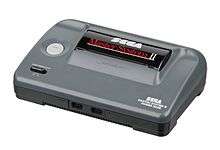
Sega released its next console, the 16-bit Mega Drive in Japan on October 29, 1988.[32] The final licensed release for the Master System in Japan was Bomber Raid in 1989.[13] In the same year, Sega was preparing to release the new Mega Drive in North America, rebranded Genesis, in North America. Displeased with Tonka's handling of the Master System, Sega reacquired the marketing and distribution rights to the Master System for the United States. In 1990, Sega released the remodeled Master System II, designed as a lower-cost version without the Sega Card slot.[13][21] Sega promoted the new model, but it sold poorly.[13] By early 1992, Master System production had ceased in North America, having sold between 1.5 million and 2 million units,[8][33] behind both Nintendo and Atari, which controlled 80 percent and 12 percent of the market respectively.[34] The last licensed Master System release in North America was Sonic the Hedgehog (1991).[13]
The Master System was successful in Europe, where it outsold the NES by a wide margin.[9][35] As late as 1993, the Master System's active installed user base in Europe was 6.25 million units, larger than that of the Mega Drive's 5.73 million.[9] Combined with the Mega Drive, Sega represented the majority of the European console that year.[35] The Master System's largest European markets were France and the United Kingdom, which had active user bases of 1.6 million and 1.35 million respectively in 1993.[9] The Master System II was also successful and helped Sega to sustain their significant market share. Releases continue into the 1990s in Europe, including Mercs (1991), Sonic the Hedgehog 2 (1992) and Streets of Rage 2.[13]
The Master System has had continued success in Brazil, where dedicated "plug and play" consoles emulating the original hardware continue to be sold by Tectoy. These systems include the Master System Compact[13] and the Master System 3,[36] and Tectoy has also received requests to remake the original Master System.[31] In 2015, it was reported that Master System plug and play systems sell around 150,000 units per year in Brazil, a level that holds its own against modern systems such as the PlayStation 4.[37] By 2016, Tectoy had sold 8 million units of Master System branded systems in Brazil.[38]
Game Gear
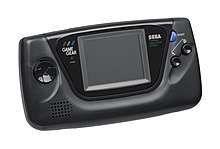
Developed under the name "Project Mercury"[39] and designed based on the Master System's hardware,[40] the Game Gear was a handheld game console. It was first released in Japan on October 6, 1990,[5] in North America and Europe in 1991, and in Australia and New Zealand in 1992.[39] Originally retailing at JP¥19,800 in Japan,[5] US$149.99 in North America, and GB£99.99 in Europe,[39] the Game Gear was designed to compete with the Game Boy, which Nintendo had released in 1989.[41] There are similarities between the Game Gear and the Master System hardware, but the games are not directly compatible; Master System games are only playable on Game Gear using the Master Gear Converter accessory.[42] A large part of the Game Gear's game library consists of Master System ports. Because of hardware similarities including the landscape screen orientation, Master System games are easily portable to the handheld.[39] In particular, many Master System ports of Game Gear games were done by Tectoy for the Brazilian market, as the Master System was more popular than the Game Gear in the region.[31]
Technical specifications
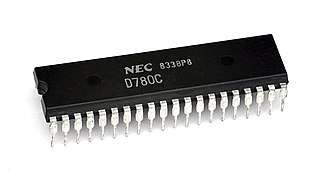
The Master System's main CPU is a Zilog Z80A, an 8-bit processor running at 4 MHz. It has 8 kB of ROM, 8 kB of RAM and 16 kB of video RAM. Video is provided through an RF switch and displays at a resolution of 256 × 192 pixels and up to 32 colors at one time from a total palette of 64 colors;[43] the graphics chip was designed by Sega for the Mark III.[14] The Master System measures 365 by 170 by 70 millimetres (14.4 in × 6.7 in × 2.8 in),[43] while the Mark III measures 318 by 145 by 52 millimetres (12.5 in × 5.7 in × 2.0 in).[44] Both consoles use two slots for game input: one for Mega Cartridges and one for Sega Cards, along with an expansion slot and 2 controller ports.[44][43] Sound is provided by the SN76489 PSG chip, which can provide three square wave channels and one noise channel. The Japanese version also integrates the YM2413 FM chip,[43] an optional feature on the Mark III. With few exceptions, Master System hardware is identical to the hardware in the Mark III. Games for the console are playable on the Sega Genesis using the Power Base Converter accessory,[13] and on the Game Gear using the Master Gear Converter.[39] Compared to the base NES, the Master System has twice as much memory and higher CPU clock rate.[16]
 |  | |||
A number of cross-compatible accessories were created for the Mark III and Master System. The controller consists of a rectangle with a D-pad and two buttons. Sega also introduced additional Mark III controllers, such as a bike handle controller and paddle controller, and a special sports controller for the Master System. A pair of 3D glasses, the SegaScope 3-D, were created for games such as Space Harrier 3D,[21] although Mark III users need an additional converter to use them. The Mark III has an optional RF transmitter accessory, allowing wireless play that broadcast the game being played on a UHF television signal.[45][46] A light gun peripheral, the Light Phaser,[21] was based on the weapon of the same name from the Japanese anime Zillion.[36]
Sega produced several iterations of the Master System. The Master System II, released in 1990, removed a number of components to reduce cost, including the Sega Card slot, reset button, power light, expansion port, and startup music and logo.[21] In Brazil, Tectoy released several licensed variations; the Master System Super Compact functions wirelessly with an RF transmitter, and the Master System Girl, molded in bright pink plastic, was targeted at girls. The Master System 3 Collection, released in 2006, contains 120 built-in games.[36] Handheld versions of the Master System were released under several brands, such as Coleco in 2006.[47]
Game library

Master System games came in two formats: ROM cartridges held up to 4 Mbit of code, while Sega Cards held up to 256 kbit. Cards, cheaper to manufacture than the cartridges, included Spy vs. Spy and Super Tennis,[13][21] but were eventually dropped due to their small memory size.[14]
Master System games include Psycho Fox, Golvellius, and Phantasy Star. Phantasy Star is considered a benchmark role-playing game (RPG), and became a successful franchise.[48] Sega's flagship character at the time, Alex Kidd, featured in games including Alex Kidd in Miracle World. Wonder Boy III: The Dragon's Trap was influential for its blend of platform gameplay with RPG elements.[49] Different Master System consoles included built-in games, including Snail Maze, Hang-On, Alex Kidd in Miracle World and Sonic the Hedgehog. After the Master System was discontinued in other markets, additional games were released in Brazil by Tectoy, including ports of Street Fighter II and Dynamite Headdy.[13]
Due in part to Nintendo's licensing practices, which stipulated that third-party NES developers could not release games on other platforms, few third-party developers released games for the Master System.[13] According to Sato, Sega was focused on porting its arcade games instead of building relationships with third parties.[14] According to Sega designer Mark Cerny, most of Sega's early Master System games were developed within a strict three-month deadline, which affected their quality.[20][50][51] Computer Gaming World compared new Sega games to "drops of water in the desert".[52] Games for the Master System took advantage of more advanced hardware compared to the NES; Alex Kidd in Miracle World, for example, showcases "blistering colors and more detailed sprites" than NES games.[53][54] The Master System version of R-Type has was praised for its visuals, comparable to those of the TurboGrafx-16 port.[55]
The Sega Mark III and the Japanese Master System are backwards-compatible with SC-3000/SG-1000 cartridges, and can play card games without the Card Catcher add-on.[56][57] However, educational and programming cartridges for the SC-3000 require the SK-1100 keyboard peripheral, which is compatible with the Mark III but not the Japanese Master System. Mark III-specific games were initially available in card format (labelled My Card Mark III to distinguish themselves from games designed for the SC-3000/SG-1000), starting with Teddy Boy Blues and Hang-On, both released on October 20, 1985.[58]
The first Mark III-specific cartridge was Fantasy Zone, released on June 15, 1986.[59] The final Mark III/Master System game published by Sega in Japan was Bomber Raid, released on February 4, 1989, a few months after the launch of the Mega Drive.[59] Games for PAL regions continued to be released until the mid-1990s.[13][60] The PAL library included 8-bit entries in Genesis franchises such as Sonic the Hedgehog and Streets of Rage and dozens of PAL-exclusives such as Lucky Dime Caper, Asterix, Ninja Gaiden, Master of Darkness and Power Strike II.[60] Retro Gamer's Damien McFerran praised the "superb" PAL library of "interesting ports and excellent exclusives", which was richer than the North American library and provided a "drip-feed of quality titles".[13]
Reception and legacy
Sales of the Master System have been estimated between 10 million and 13 million units, not including later Brazil sales.[5][6] It saw much more continued success in Europe and Brazil than it did in Japan and North America.[13] In 1989, the Sega Master System was listed in the top 20 products of NPD Group's Toy Retail Sales Tracking Service.[61] However, the Electronic Gaming Monthly 1992 Buyer's Guide indicated a souring interest in the console. Four reviewers scored it 5, 4, 5, and 5 out of a possible 10 points each, focusing on the better value of the Genesis and lack of quality games for the Master System.[62] In 1993, reviewers scored it 2, 2, 3, and 3 out of 10, noting its abandonment by Sega in North America and lack of new releases.[63]
By contrast, 62 million NES units were sold in North American, outselling the Master System several times over.[6] According to Bill Pearse of Playthings, the NES gained an advantage through better software and more recognizable characters.[64] Sega closed the gap between Nintendo in the next generation with the release of the Genesis, which sold 30.75 million consoles compared with the 49 million Super Nintendo Entertainment System consoles.[65][66]
Retrospective feedback of the Master System praises its support toward development of the Sega Genesis, but has been critical of its small game library. Writing for AllGame, Dave Beuscher noted that the Master System "was doomed by the lack of third-party software support and all but disappeared from the American market by 1992".[21] However, Retro Gamer praised the larger PAL library as a "superb library of interesting ports and excellent exclusives".[60] Damien McFerran of Retro Gamer recognized its importance to the success of the Genesis, stating, "Without this criminally undervalued machine, Sega would not have enjoyed the considerable success it had with the Mega Drive. The Master System allowed Sega to experiment with arcade conversions, original IP and even create a mascot in the form of the lovable monkey-boy Alex Kidd."[13]
In 2009, the Master System was named the 20th best console of all time by IGN, behind the Atari 7800 (17th) and the NES (1st). IGN cited the Master System's small and uneven NTSC library as the major problems: "Months could go by between major releases and that made a dud on the Master System feel even more painful."[67] The Master System retains a following.[67] In 2019, Sega Master System: A Visual Compendium was published by Bitmap Books,[68] a licensed book looking at the history of the console and its games.[69]
In 2005, Sega reached a deal with Chinese company AtGames to release emulated Master System software in Taiwan, Hong Kong, and China.[70] Several Master System games were released for download on Nintendo's Wii Virtual Console, beginning with Fist of the North Star in 2008 in Japan and Wonder Boy in North America..[71] Master System games were also released via the GameTap online service.[72]
Notes
- Japanese models only.
- Japanese models only.
- Japanese: セガ・マスターシステム Hepburn: Sega Masutā Shisutemu
- Sega Genesis and Mega Drive are the same console. It was known as Genesis in North America and Mega Drive worldwide
References
- "Mark III" (in Japanese). Sega Corporation. Archived from the original on July 16, 2014. Retrieved March 31, 2014.
- Gamers High! Futabasha Super Mook (in Japanese). Futabasha. 2015. p. 55. ISBN 978-4-575-45554-0.
- Computer Entertainer, February 1987, page 13 Archived November 22, 2015, at the Wayback Machine
- "Master System" (in Japanese). Sega Corporation. Archived from the original on July 16, 2014. Retrieved March 31, 2014.
- Forster, Winnie (2005). The Encyclopedia of Game.Machines: Consoles, Handhelds, and Home Computers 1972–2005. Magdalena Gniatczynska. p. 139. ISBN 3-00-015359-4.
- Buchanan, Levi (March 20, 2009). "Genesis vs. SNES: By the Numbers". IGN. Ziff Davis. Archived from the original on March 2, 2014. Retrieved March 31, 2014.
- Nihon Kōgyō Shinbunsha (1986). "Amusement". Business Japan. Nihon Kogyo Shimbun. 31 (7–12): 89. Retrieved January 24, 2012.
- Sheff, David (1993). Game Over (1st ed.). New York, New York: Random House. p. 349. ISBN 0-679-40469-4. Retrieved January 16, 2012.
- "Sega Consoles: Active installed base estimates". Screen Digest. Screen Digest Ltd.: 60 March 1995.
- "SG-1000" (in Japanese). Sega Corporation. Archived from the original on July 16, 2014. Retrieved February 12, 2014.
- Kohler, Chris (October 2009). "Playing the SG-1000, Sega's First Game Machine". Wired. Condé Nast Publications. Archived from the original on January 1, 2014. Retrieved October 5, 2009.
- "G&W Wins Cheers $1 Billion Spinoff Set". The Miami Herald – via NewsBank (subscription required) . August 16, 1983. Archived from the original on November 10, 2013. Retrieved October 10, 2013.
- McFerran, Damien. "Retroinspection: Master System". Retro Gamer. London, UK: Imagine Publishing (44): 48–53. ISSN 1742-3155.
- Sato, Hideki; Famitsu DC (February 15, 2002). Interview: The Witness of History. セガ・コンシューマー・ヒストリー (Sega Consumer History). Famitsu Books (in Japanese). Enterbrain. pp. 22–25. ISBN 978-4-75770789-4. (Translation by Shmuplations. Archived 2020-08-14 at the Wayback Machine).
- Plunkett, Luke (February 27, 2012). "The Story of Sega's First Ever Home Console". Kotaku. Gawker Media. Archived from the original on September 15, 2014. Retrieved September 14, 2014.
- Parkin, Simon (June 2, 2014). "A history of video game hardware: Sega Master System". Edge. Future plc. Archived from the original on June 5, 2014. Retrieved September 13, 2014.
- Sato (September 18, 2013). "Sega's Original Hardware Developer Talks About The Company's Past Consoles". Siliconera. Curse LLC. Archived from the original on December 2, 2013. Retrieved November 23, 2013.
- "Bruce Lowry: The Man That Sold the NES". Game Informer. GameStop. 12 (110): 102–103. June 2002.
- Horowitz, Ken (2016). Playing at the Next Level: A History of American Sega Games. McFarland & Company. pp. 6–15. ISBN 9781476625577.
- Horowitz, Ken (December 5, 2006). "Interview: Mark Cerny". Sega-16. Ken Horowitz. Archived from the original on October 17, 2014. Retrieved April 16, 2014.
- Beuscher, David. "Sega Master System – Overview". AllGame. All Media Network. Archived from the original on January 2, 2010. Retrieved March 31, 2014.
- Takiff, Jonathan (June 20, 1986). "Video Games Gain In Japan, Are Due For Assault On U.S." The Vindicator. p. 2. Archived from the original on April 3, 2017. Retrieved April 10, 2012.
- McGill, Douglas C. (December 4, 1988). "Nintendo Scores Big". The New York Times. Archived from the original on May 24, 2013. Retrieved March 27, 2009.
- Horowitz, Ken (2016). Playing at the Next Level: A History of American Sega Games. McFarland & Company. pp. 6–15. ISBN 978-1-4766-2557-7.
- Hewison, Richard. "From the Archives: Virgin Games, Part 1". Retro Gamer. London, UK: Imagine Publishing (84): 50–55. ISSN 1742-3155.
- McFerran, Damien (July 22, 2014). "Hardware Classics: Sega Master System". Nintendo Life. Archived from the original on September 14, 2014. Retrieved September 13, 2014.
- "Master System completa 20 anos de vida no Brasil". Universo Online (in Portuguese). Grupo Folha. September 4, 2009. Archived from the original on February 27, 2014. Retrieved February 21, 2014.
- "Tec Toy lança no País o videogame Mega Drive". O Estado de S.Paulo (in Portuguese). 111 (35513). São Paulo: Grupo Estado. November 22, 1990. p. 81. ISSN 1516-2931. Archived from the original on March 4, 2016.
- "Estrela e Gradiente trazem jogos Nintendo". Folha de S.Paulo (in Portuguese). 73 (23360). São Paulo: Grupo Folha. March 18, 1993. pp. 2–13. ISSN 1414-5723. Archived from the original on March 3, 2016.
- Szczepaniak, John (November 2006). "Company Profile: Tec Toy". Retro Gamer. No. 30. Imagine Publishing. pp. 50–53. ISSN 1742-3155.
- Sponsel, Sebastian (November 16, 2015). "Interview: Stefano Arnhold (Tectoy)". Sega-16. Ken Horowitz. Archived from the original on November 22, 2015. Retrieved November 30, 2015.
- Sczepaniak, John (2006). "Retroinspection: Mega Drive". Retro Gamer. London, UK: Imagine Publishing (27): 42–47. ISSN 1742-3155.
- "16-Bit Hits – New video games offer better graphics, action". Minneapolis Star Tribune – via NewsBank (subscription required) . October 15, 1991. Archived from the original on November 10, 2013. Retrieved April 7, 2014.
- "Company News; Nintendo Suit by Atari Is Dismissed". The New York Times. May 16, 1992. Archived from the original on October 23, 2014. Retrieved September 19, 2014.
- Total 8-bit and 16-bit Cartridge Consoles: Active installed base estimates. Screen Digest. Screen Digest Ltd. March 1995. p. 61. (cf. here Archived March 24, 2017, at the Wayback Machine and here Archived March 24, 2017, at the Wayback Machine)
- Szczepaniak, John (2006). "Company Profile: Tec Toy". Retro Gamer. London, UK: Imagine Publishing (30): 50–53. ISSN 1742-3155.
- Smith, Ernie (July 27, 2015). "Brazil Is An Alternate Video Game Universe Where Sega Beat Nintendo". Atlas Obscura. Archived from the original on June 21, 2017. Retrieved December 11, 2017.
- Azevedo, Théo (May 12, 2016). "Console em produção há mais tempo, Master System já vendeu 8 mi no Brasil". Universo Online (in Portuguese). Grupo Folha. Archived from the original on May 14, 2016. Retrieved May 13, 2016.
Comercializado no Brasil desde setembro de 1989, o saudoso Master System já vendeu mais de 8 milhões de unidades no país, segundo a Tectoy.
- "Retroinspection: Sega Game Gear". Retro Gamer. London, UK: Imagine Publishing (41): 78–85. 2009. ISSN 1742-3155.
- Buchanan, Levi (October 9, 2008). "Remember Game Gear?". IGN. Ziff Davis. Archived from the original on April 23, 2010. Retrieved March 29, 2009.
- Beuscher, David. "Sega Game Gear – Overview". AllGame. All Media Network. Archived from the original on November 14, 2014. Retrieved July 8, 2013.
- Dandumont, Pierre (November 26, 2017). "Ces jeux Game Gear qui sont en fait des jeux Master System". journaldulapin.com (in French). Retrieved July 7, 2020.
- "Master System data" (in Japanese). Sega Corporation. Archived from the original on April 7, 2014. Retrieved March 30, 2014.
- "Mark III data" (in Japanese). Sega Corporation. Archived from the original on August 14, 2014. Retrieved March 30, 2014.
- "Master System peripherals" (in Japanese). Sega Corporation. Archived from the original on April 7, 2014. Retrieved March 31, 2014.
- "Mark III peripherals" (in Japanese). Sega Corporation. Archived from the original on August 14, 2014. Retrieved March 31, 2014.
- Ransom-Wiley, James (October 26, 2006). "Coleco Tiptoes Back with Sega-filled Handheld". Joystiq. AOL. Archived from the original on April 7, 2014. Retrieved April 22, 2010.
- Semrad, Steve (February 2, 2006). "The Greatest 200 Videogames of Their Time, Page 8". 1UP.com. Archived from the original on January 18, 2014. Retrieved December 11, 2016.CS1 maint: BOT: original-url status unknown (link)
- Mott, Tony (2013). 1001 Video Games You Must Play Before You Die. New York, New York: Universe Publishing. p. 177. ISBN 978-0-7893-2090-2.
- Parkin, Simon (September 13, 2013). "Sonic the Hedgehog: past, present and future". The Guardian. Guardian Media Group. Archived from the original on June 25, 2014. Retrieved June 6, 2014.
They made 40 games in this way ...But by my judgment only two were really worth playing.
- Totilo, Stephen (March 10, 2014). "A Candid Talk With Mark Cerny, Who Designed The PS4, Among Other Things". Kotaku. Gizmodo Media Group. Archived from the original on June 4, 2014. Retrieved June 6, 2014.
- Kunkel, Bill; Worley, Joyce; Katz, Arnie (November 1988). "Video Gaming World". Computer Gaming World. p. 54. ISSN 0744-6667. Archived from the original on April 5, 2016.
- Buchanan, Levi (January 25, 2008). "Alex Kidd in Miracle World Review". IGN. Ziff Davis. Archived from the original on March 11, 2014. Retrieved March 31, 2014.
- cf. Mott, Tony (2013). 1001 Video Games You Must Play Before You Die. New York, New York: Universe Publishing. p. 108. ISBN 978-0-7893-2090-2.
- "Retro Reviews: R-Type". Game Informer. GameStop. 12 (114): 114. October 2002.
- "[セガハード大百科] ゲームカートリッジ For SC/SG" [Sega Hardware Encyclopedia: Game Cartridge for SC/SG]. Archived from the original on December 27, 2018. Retrieved December 27, 2018.
- "[セガハード大百科] セガ マイカード" [Sega Hardware Encyclopedia: Sega My Card]. Archived from the original on December 27, 2018. Retrieved December 27, 2018.
- "[セガハード大百科] マイカードマークIII" [Sega Hardware Encyclopedia: Sega My Card Mark III]. Archived from the original on December 27, 2018. Retrieved December 27, 2018.
- "[セガハード大百科] セガマーク3/マスターシステム対応ソフトウェア" [Sega Hardware Encyclopedia: List of Sega Mark III/Master System software]. Archived from the original on December 27, 2018. Retrieved December 27, 2018.
- "The Collector's Guide: Sega Master System", Retro Gamer, issue 117, pages 20–31, 2013
- Leccesse, Donna (May 5, 1989). "Retailers say video is a dream come true; Nintendo is leading the way to better sales". Playthings. Sandow Media LLC. Archived from the original on September 21, 2014. Retrieved September 13, 2014 – via HighBeam Research(subscription required).
- Steve; Ed; Martin; Sushi-X (January 1992). "EGM Rates The Systems Of 1992!!!". Electronic Gaming Monthly. Sendai Publishing: 74.
- Steve; Ed; Martin; Sushi-X (January 1993). "Electronic Gaming Monthly's Buyer's Guide". Electronic Gaming Monthly. Sendai Publishing: 32.
- Pearse, Bill (January 1, 1992). "Nintendo and Sega gear up for battle. (Nintendo of America Inc. and Sega Inc. compete for 16-bit video game market; includes related articles) (Industry Overview)". Playthings. Sandow Media LLC. Archived from the original on October 28, 2014. Retrieved September 13, 2014 – via HighBeam Research(subscription required).
- Zackariasson, Peter; Wilson, Timothy L.; Ernkvist, Mirko (2012). "Console Hardware: The Development of Nintendo Wii". The Video Game Industry: Formation, Present State, and Future. Routledge. p. 158. ISBN 978-1-138-80383-1.
- "Sonic Boom: The Success Story of Sonic the Hedgehog". Retro Gamer — the Mega Drive Book. London, UK: Imagine Publishing: 31. 2013. ISSN 1742-3155.
- "Top 25 Videogame Consoles of All Time: SEGA Master System is Number 20". IGN. Ziff Davis. 2009. Archived from the original on February 22, 2014. Retrieved March 31, 2014.
- Nintendo Life Staff (June 18, 2019). "Gallery: Flicking Through Sega Master System: A Visual Compendium". Nintendo Life. Archived from the original on July 5, 2019. Retrieved July 4, 2019.
- Nintendo Life Staff (July 2, 2018). "Kickstarter For The Sega Master System Visual Compendium Is Now Live". Nintendo Life. Archived from the original on July 5, 2019. Retrieved July 4, 2019.
- "Sega expands distribution in Greater China". Screen Digest. Screen Digest Ltd. March 1, 2005. Archived from the original on September 21, 2014. Retrieved September 13, 2014 – via HighBeam Research(subscription required).
- "Cruis'n USA and Wonder Boy Now Available on Wii Shop Channel!". Nintendo. Archived from the original on July 23, 2008. Retrieved March 15, 2010.
- Leupold, Tom (February 3, 2006). "Games on tap, or 'History of the Gaming World, Part I'". Oakland Tribune. Archived from the original on September 24, 2014 – via HighBeam Research(subscription required).
